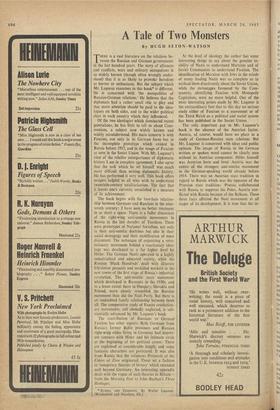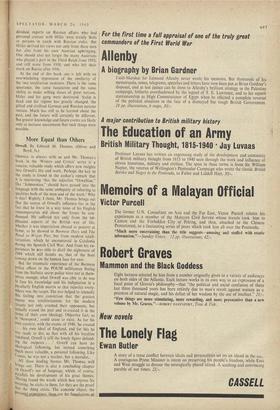A Tale of Two Monsters
By HUGH SETON-WATSON 'THERE is a vast literature on the relations be- tween the Russian and German governments in the last hundred years. The story of alliances and conflicts, wars and military occupations is so widely known (though often wrongly under- stood) that it is as likely to provoke boredom as horror or enthusiasm. But the subject which Mr. Laqueur examines in this book* is different. He is concerned with 'the metapolitics of Russian-German relations.' He believes that the diplomats had a rather small role to play and that more attention should be paid to the ideo- logues on both sides, and to the wider political class in each country which they influenced.
Of the two ideologies which dominated recent generations, he has little to tell us about Com- munism, a subject now widely known and widely misunderstood. His main concern is with Fascism, not only in its German form but in the incomplete prototype which existed in Russia before 1917, and in the image of Fascism as seen in the Soviet Union. With Mr. Laqueur's view of the relative unimportance of diplomatic
history I am in complete agreement. I also agree that the task which he set himself was much
more difficult than writing diplomatic history.
He has performed it very well. This book offers insights helpful to all who wish to understand
twentieth-century totalitarianism. The fact that it leaves one's curiosity unsatisfied is a measure of its achievement.
The book begins with the love-hate relation- ship between Germans and Russians in the nine-
teenth century: I have seen no better treatment in so short a space. There is a fuller discussion of the right-wing anti-semitic movements in
Russia in the last decades of Tsardom. These were prototypes of National Socialism, not only in their anti-semitic doctrines but also in their social demagogy and their mobilisation of mass discontent. The technique of organising a revo- lutionary movement behind a reactionary ideo- logy was developed to a far higher level by Hitler. The German Nazis operated in a highly industrialised and educated society, while the Russian 'Black Hundreds' dealt with illiterate Ukrainian peasants and unskilled workers in the new towns of the first stage of Russia's industrial revolution. The anti-semitic mass movement which developed in Rumania in the 1930s, and to a lesser extent those in Hungary, Slovakia and Poland, more closely resembled the Russian movement than did the Nazi Party. But there is an undoubted family relationship between them
all. The comparative study of Fascist revolution- ary movements, still absurdly neglected, is sub- stantially advanced by Mr. Laqueur's book.
The contribution of Russians to German' Fascism has other aspects. Both Germans from Russia's former Baltic provinces and Russian right-wing exiles living in. Germany had import- ant contacts with Hitler and his intimate circle at the beginning of his political career. TheSe are explained at considerable length, and some fantastic characters are portrayed. It was also from Russia that the infamous Protocols of the
Elders• of Zion originated. These set a fashion in 'conspiracy theories of history' which extended well beyond Germany. An interesting appendix deals with the vogue of such theories in Britain— from the Morning Post to John Buchan's Three Hostages.
* RUSSIA AND GERMANY. By Walter Laqueur.
(Weidenfeld and Nicolson, 45s.)
At the level of ideology the author has some interesting things to say about the genuine in- ability of Nazis to understand Marxism and of Soviet Communists to understand Fascism. The identification of Marxism with Jews in the minds of many leading Nazis was so complete as to mislead them disastrously about the Soviet Union, while the stereotypes favoured by the Com- munists, Identifying Fascism with Monopoly Capitalism, were no more helpful. One of the most interesting points made by Mr. Laqueur is the extraordinary fact that to this day no serious study either of Fascism as a " movement or of the Third Reich as a political and social system has been published in the Soviet Union.
The only important gap in Mr. Laqueur's book is the absence of the Austrian factor. Austria, of course, would have no place in a study of German-Russian state relations. But Mr. Laqueur is concerned with ideas and public opinion. The image of Russia in the German written or spoken word cannot be clearly seen without its Austrian component. Hitler himself was Austrian born and bred. Austria was the centre of the strongest anti-semitic movement in the German-speaking world already before 1914. There was an Austrian state tradition in regard to Russia which was the opposite of the Prussian state tradition: Prussia collaborated with Russia to suppress the Poles, Austria con- flicted with Russia because of the Balkans. These three facts affected the Nazi movement at all stages of its development. It is true that the in-
dividual experts on Russian affairs who had personal contact with Hitler were mainly Baits or persons in touch with Russian exiles. But Hitler derived his views not only from these men but also from his own Austrian upbringing. One should also not forget the many Austrians who played a part in the Third Reich from 1933, and still more from 1938.. and who left their mark on Russia after 1941.
At the end of this book one is left with an overwhelming impression of the similarity of the two totalitarian monsters. There is the same ignorance, the same fanaticism and the same ability to make willing slaves of great nations. Hitler and his gang were destroyed. Stalin is dead and his regime has greatly changed. the gifted and civilised German and Russian nations remain. Much has still to be learned about the past, and the future will certainly be ditlerent. But greater knowledge and future events are likely only to increase amazement that such things were Possible.















































 Previous page
Previous page